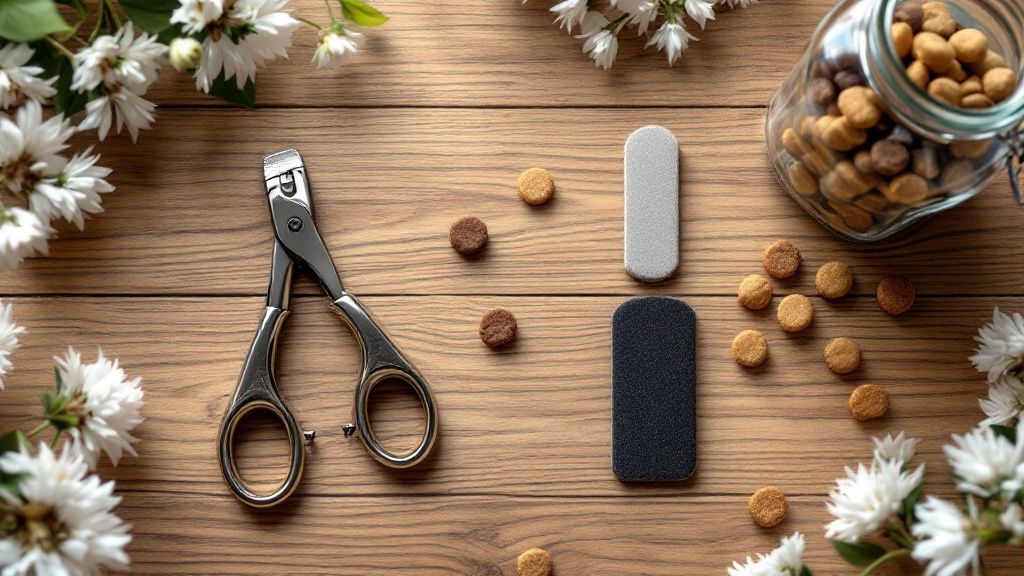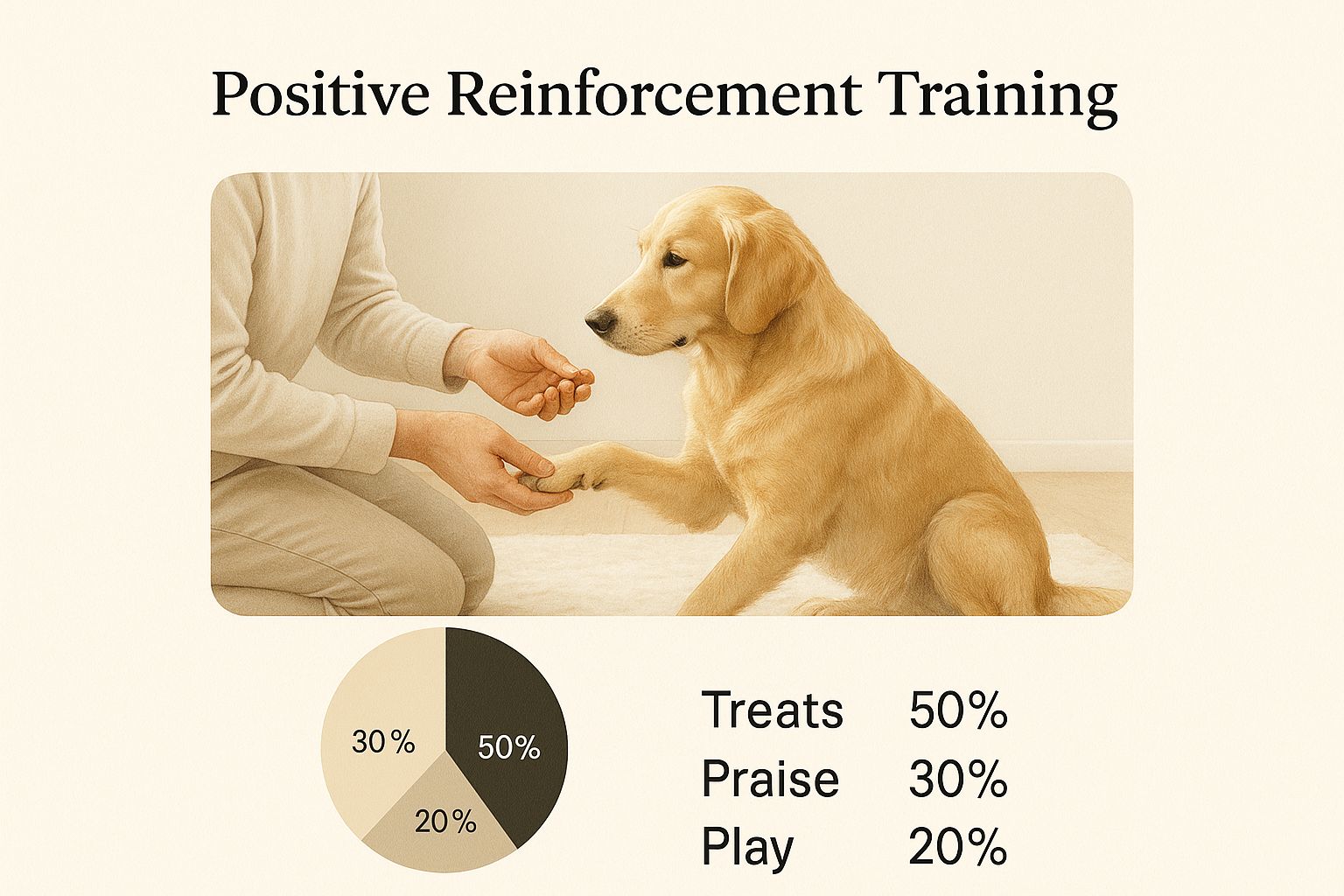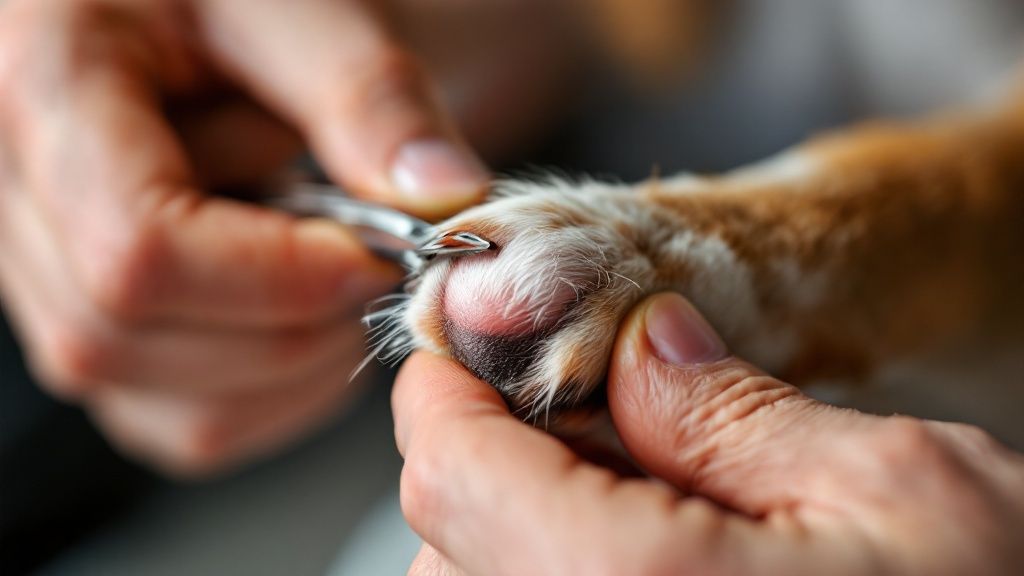Learning how to trim a dog's nails comes down to a few key things: gathering the right tools, making sure the environment is calm, and carefully clipping only the very tip of the nail to avoid the sensitive quick. By taking off just tiny slivers at a time, we can safely look after our dog’s nail health and keep them comfortable.
Why Nail Trimming Is an Act of Love
It’s easy to see nail trimming as just another chore on the list, maybe even one you dread. We get it. The thought of accidentally hurting your best friend is enough to make anyone anxious. But what if we shifted our perspective together? Let’s try to see this not as a battle, but as one of the kindest, most loving things you can do for your dog.
This small act of care has a massive impact on their daily comfort and long-term health. Overgrown nails are more than just a cosmetic issue; they can subtly force your dog to change their posture and the way they walk. Imagine wearing shoes that are a size too small—eventually, you'd start shifting your weight awkwardly, and that discomfort would travel up your legs and back. It’s exactly the same for our dogs.
The Hidden Impact of Long Nails
When your dog’s nails get too long, they constantly push back into the nail bed, putting a lot of pressure on the toe joints. This can trigger a real domino effect of physical strain.
- Joint and Posture Problems: That unnatural pressure can misalign the joints in their feet, which can lead to strain on their legs and even their spine over time.
- Reduced Traction: Long nails stop their paw pads from making proper contact with the ground. This increases the risk of slips and falls, which is a particular worry for older dogs.
- Pain and Discomfort: In the worst cases, a nail can curl right around and grow into the paw pad, causing serious pain and potential infection.
For many of us, the first sign of a problem is hearing that familiar click-clack on the kitchen floor. That clicking is a clear signal your dog's nails are touching the ground when they stand, and it means it's definitely time for a trim.
This isn’t about giving them a perfect pedicure. It’s about preventing chronic pain and making sure your dog can run, play, and walk with ease. In fact, The Kennel Club points to long nails as one of the top five most common health issues in dogs because of the negative effects on their gait and comfort.
By embracing this routine, you’re not just ticking a grooming task off the list; you’re protecting your companion’s future well-being. It’s a vital part of the bond you share.
Choosing The Right Nail Trimming Tools
Stepping into a pet store can feel a bit overwhelming with all the clippers, grinders, and gadgets lining the shelves. Let’s cut through the noise together and figure out what will actually work for you and your dog. Picking the right tool is your very first step towards trimming your dog's nails with confidence.
You'll find there are really just three main options to consider. Which one you go for will depend on your dog’s size, the thickness of their nails, and frankly, their general attitude towards having their paws handled.
Finding The Perfect Fit
The most common tools you'll see are the scissor-style clippers, which work just like a normal pair of scissors. In our experience, they’re excellent for larger dogs who have thick, tough nails, as they give you plenty of leverage for a clean, decisive cut.
For smaller dogs, you might prefer the guillotine-style clippers. With these, the nail pops through a little hole and a blade slices it off. They’re very quick, but we've seen them crush more delicate nails if you’re not careful.
Finally, there are the electric nail grinders. These clever tools file the nail down bit by bit, which is a fantastic option if you're nervous about cutting too close to the quick. They’re also a godsend for dogs who can't stand the ‘snap’ sound of traditional clippers.
This image really drives home the point that creating a calm, positive experience with plenty of treats is just as important as the tools you're using. Successful nail care is a partnership built on trust and a little bit of bribery!
To help you decide, here’s a quick look at the different types of nail trimmers and what they’re best for.
Comparing Dog Nail Trimming Tools
| Tool Type | Best For | Pros | Cons |
|---|---|---|---|
| Scissor-Style Clippers | Larger dogs with thick, tough nails. | Provides good leverage for a clean cut; very durable. | Can be intimidating for beginners; requires more force. |
| Guillotine-Style Clippers | Small to medium-sized dogs with thinner nails. | Quick and easy to use; requires less pressure. | Can crush brittle nails; blade needs frequent replacement. |
| Electric Nail Grinder | Anxious dogs; owners nervous about cutting the quick. | Low risk of cutting the quick; creates a smooth finish. | Can be noisy and vibrate; slower than clipping. |
Ultimately, the best tool is simply the one you feel most comfortable and confident using. Your calmness (or your stress!) will transfer directly to your dog, making the whole process much smoother for both of you.
Beyond the main trimming tool, a couple of other items are essential for your kit. Styptic powder is an absolute must-have; it quickly stops any bleeding if you accidentally snip the quick. Think of it as your 'oops' insurance – it provides huge peace of mind.
Also, make sure you have a good stock of high-value treats to reward your dog for being patient. Nail trimming is just one piece of the puzzle; for more great tips, you can learn more about how to groom your dog at home in our comprehensive guide.
Creating a Calm Nail Care Routine
Here’s a little secret: a peaceful nail trim has almost nothing to do with the actual clipping. It’s all about the groundwork we lay beforehand, creating a calm, predictable environment long before the clippers even make an appearance. If your dog already gets anxious about having their paws touched, pulling out a strange tool is only going to escalate things.
This is where we always introduce the idea of 'paw conditioning'. It’s a gentle process of getting your dog completely comfortable with you handling their feet, and it's something you can practise for just a few minutes each day. The whole point is to show them that paw-touching is a normal, rewarding experience, not something to be feared.
Think of it as building a partnership. Instead of forcing the situation, we're teaching our dogs that nail care is a team effort. A calm routine shows your dog you're on their side, and believe us, that makes all the difference.
Setting the Stage for Success
The environment you're in plays a massive role in your dog’s state of mind. Trying to trim nails in a busy, noisy room while everyone is rushing about is a recipe for stress. Instead, it pays to choose your moment wisely.
- Pick a Quiet Time: We find the best time for nail care is when a dog is already chilled out, perhaps after a good long walk or in the evening when they’re snoozing on the sofa.
- Find a Calm Space: Choose a quiet room away from the household chaos where you won't be interrupted. Soft lighting and a comfy spot for both of you can work wonders for setting a tranquil mood.
The most important takeaway here is patience. We are working at our dog's pace, not ours. If they seem stressed, it's absolutely okay to stop and try again tomorrow. Each positive interaction builds more trust for the next session.
Some dogs, no matter how patient we are, just have a higher baseline of anxiety. For these pups, bringing in some extra support can be a game-changer. You might want to look into using special calming dog treats to help ease their nerves before a grooming session. It's all about using every tool in your toolbox to make this a positive experience for them.
Right, deep breath. This is it. We're going to get through this together, one nail at a time. The aim here is patience and safety, not a perfect Crufts-worthy pedicure. All that calm energy we worked on building? Let's put it to good use now.
First things first, get comfy. Find a position where you can hold your dog's paw securely but without a death grip. You're supporting them, not pinning them down. Hold the paw firmly but keep your own hands relaxed. Single out one toe between your thumb and forefinger, and give the paw pad a gentle squeeze to push the nail out a little further.
Finding the Quick and Making the Cut
Now for the scary bit – the quick. This is just the bundle of nerves and blood vessels running down the centre of the nail. If your dog has light-coloured nails, you're in luck; you can usually see it as a pinkish bit inside. On dark nails, though, it's completely invisible, which is why we need to be extra cautious.
This is where the 'salami slice' technique is your best mate. Instead of lopping off a big chunk in one go, we're just going to take the teeniest, tiniest sliver off the very tip.
- First Sliver: Just snip off the sharp, pointy end. That's it.
- Have a Gander: Look at the cut surface of the nail. If it's all a whitish or greyish colour, you're safe to take another tiny slice.
- Spot the Dot: As you get closer to the quick, you’ll start to see a small, dark, almost fleshy-looking dot appear in the middle of the cut nail. That's your stop sign. Go no further.
This little-and-often approach is genuinely the safest way to trim a dog's nails, especially when you're flying blind with dark nails. It keeps you in control and makes accidentally causing pain much, much less likely. It's surprising how many dogs don't get this done at the vets; a study by the Royal Veterinary College found that only about 5.64% of dogs have their nails clipped during primary care vet visits. This just goes to show how often this job lands in our laps as owners.
What to Do if You Cut the Quick
Look, it happens. Even seasoned vets and professional groomers nick the quick from time to time. The most important thing is to stay calm. Your dog will feed off your reaction, and if you start panicking, they will too.
If you see a spot of blood, don't spiral. Just grab a pinch of styptic powder, press it firmly onto the end of the nail, and hold it there for about 30 seconds. The bleeding will stop almost instantly.
Once the drama is over, give your dog a really tasty treat and tons of praise. Then, take a moment. If you both feel up to it, you can move on to another paw. If not, that's absolutely fine. End the session on a positive note and try again another day. How you handle it is what your dog will remember.
When to Call in the Professionals
Sometimes, the smartest and kindest thing you can do is hand the clippers over to a professional. There’s absolutely no shame in it. In fact, knowing when to get help is the mark of a great dog owner. At the end of the day, your dog’s well-being and your own peace of mind are what truly matter.
Not every nail trim needs to be a DIY job. There are plenty of situations where getting a trusted groomer or your vet involved is the best move for both of you.
Signs It's Time for an Expert
You should seriously consider professional help if you find yourself in any of these situations:
- Extreme Anxiety: If your dog is showing signs of severe stress, panic, or even aggression, pushing it at home can make things much worse long-term. Professionals are trained to handle anxious dogs calmly and safely.
- Severely Overgrown Nails: When nails get really long, sometimes even curling into the paw pad, the quick also extends. A professional knows exactly how to shorten these nails gradually and safely without causing any pain.
- You're Not Confident: If the mere thought of trimming your dog's nails fills you with dread, your dog will pick up on that anxiety. It’s perfectly fine to admit you're not comfortable with the task.
Choosing a professional isn't giving up; it's about prioritising safety and making sure the experience is a positive one for your dog. A quick, calm session with an expert is far better than a stressful, drawn-out struggle at home.
The UK pet grooming market is growing fast, which just goes to show how many of us are opting for professional care. With nail trimming being a standard service, finding help is easier than it's ever been.
Finding a qualified expert you can trust is the most important step. If you're looking for local options, our guide to some of the best dog groomers in Sheffield could be a great place to start your search.
Got Questions About Nail Trims? You're Not Alone.
We get it. Even with a guide in hand, it's easy to feel hesitant before you actually pick up those clippers. We hear the same worries from fellow dog lovers all the time, so we've put the most common ones right here to give you that final bit of confidence.
It's completely normal to feel a bit nervous, but with the right info, you can absolutely do this. Let's tackle those nagging doubts together.
How Often Should I Be Trimming My Dog's Nails?
There’s no magic number that works for every dog. Honestly, the best indicator is the sound they make – if you can hear their nails clicking on your kitchen floor, it’s definitely time for a trim. As a general rule of thumb, their nails shouldn't be touching the ground when they're just standing normally on a flat surface.
For most dogs, this works out to a trim every 3 to 4 weeks. But, a very active dog who spends hours running on pavement might naturally wear their nails down and need them trimmed far less often. The trick is to watch, listen, and get to know your own dog's unique needs.
My Dog Has Black Nails – How Do I Avoid the Quick?
This is probably the biggest fear we hear about, and it's completely understandable. When you can’t see the quick, the best way forward is with patience and a careful, methodical approach. That 'salami slice' method we talked about earlier is your best friend here.
- Take tiny slivers: Never try to lop off a big chunk at once. Just snip the very tip.
- Check the nail head-on: After each little snip, have a look at the cut surface of the nail.
- Look for the dot: As you get closer to the quick, you’ll start to see a small, dark, fleshy-looking dot appear in the centre. That’s your absolute stop sign.
An electric nail grinder can be a real game-changer for black nails. It files the nail down so gradually that it gives you much more control and makes it almost impossible to make a major mistake. It turns a scary guessing game into a slow, controlled process.
What if My Dog Absolutely Panics During Nail Trims?
If your dog is showing real signs of fear—shaking, growling, or trying to bite—never force the issue. Pushing through their panic will only make their anxiety worse and make future attempts a hundred times harder. It’s a clear sign that we need to take a big step back and work on rebuilding their trust.
Your first move should be to go right back to the beginning with desensitisation. Spend a few days just briefly touching their paws and immediately rewarding them with a super high-value treat, like a little piece of chicken. Let them simply sniff the clippers while you shower them with praise and treats.
If their fear is severe and you’re not making any progress, the kindest and safest thing you can do is call in a professional groomer or your vet. They have the training and experience to handle anxious dogs humanely, turning what could be a traumatic event into a safe, routine procedure.
At K9 Time, we know that every part of your dog's care, from daily walks to routine grooming, adds up to a happy, healthy life. If you need a trusted partner to help look after your best friend in Sheffield, have a look at our professional dog walking services.





